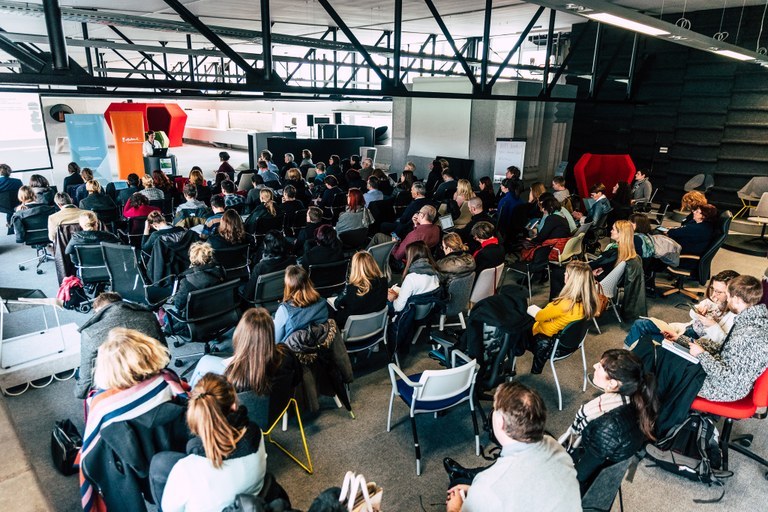Sustainable design as one of key building blocks of transition to a circular economy

Ljubljana, 27 March 2018 – Measures supporting the transition to a circular economy are becoming a permanent fixture in development policies at both national and EU level. Today’s conference ‘’Sustainable Design for Transition to Circular Economy’’ puts into spotlight sustainable design as one of key enablers of the shift towards a low-carbon society. The Retrace-related conference is hosted by the Government Office for Development and European Cohesion Policy and the Centre for Creativity which operates under the auspices of the Museum for Architecture and Design. Alenka Smerkolj and Tone Peršak, members of the caretaker government, and Erik van Uum, Deputy Head of Mission, Embassy of the Kingdom of the Netherlands are to deliver opening addresses.
The shift to a circular economy largely depends on economic growth, but the process will only be successful if joint efforts are made to prevent economic growth from resulting in over-exploitation of primary raw materials and non-renewable energy sources. This progress cannot happen without a step change in consumer behaviour and production patterns; thus, application of the system-wide concept of sustainable design in different processes will help lead the way forward. Project Retrace (A Systemic Approach for Regions Transitioning towards a Circular Economy) which is implemented under the Interreg Europe Programme promotes the use of systemic design as a method facilitating the shift to a circular economy. The project brings together eight partners from Italy, Spain, Romania, France and Slovenia which is represented by the Government Office for Development and European Cohesion Policy (GODC) and joined the project in April 2016.
Caretaker Minister for Development, Strategic Projects and Cohesion Alenka Smerkolj in her opening remarks expressed pleasure to see seven out of eight Slovenian best practices of circular design make it to the top thirty list from a long list of 65 good practices of circular economy identified under the project Retrace. ‘’Slovenia is on the right track, including as regards the design of development policies which underpin the shift to a circular economy. Our Operational Programme laid the foundation for action in this area, which was upgraded by the adoption of Slovenian Smart Specialisation Strategy, and, recently, Slovenia’s Development Strategy 2030. The latter places the transition of the country to a low-carbon economy among the twelve headline goals it pursues,’’ added minister.
Tone Peršak, Caretaker Minister of Culture explained that circular economy has been one of the essential elements in the development of the national Design Strategy and highlighted that ‘’circular economy seems something natural and self-evident in an unspoilt land rich in natural resources, which Slovenia definitely is. Our country has the opportunity to harness the untapped potential and to create high added value.
Marjana Dermelj from GODC who coordinates Retrace activities in Slovenia presented the Action Plan on the Use of Systemic Design for Transition to a Circular Economy which was developed under the project. The Action Plan aims to support the first concrete steps towards making sustainable design part of a systemic approach to design of policies, financial instruments and other support mechanisms. Anja Zorko from the Centre for Creativity at the Museum for Architecture and Design underlined the importance of collaboration between the creative sector and the economy, and the role of design in industrial production processes.
Miranda Geusens from OVAM (Public Waste Agency of Flanders, Belgium) outlined theoretical approaches in the area of sustainable design and identified the tools which encourage both the education sphere and the corporate sector to embrace the principle of integrating sustainability in their design process. Saskia van den Muijsenberg from BiomimicryNL discussed ways to put theory into practice and looked into examples of learning from nature, and practical solutions to processes and products were presented by Bert van Son from the Dutch denim brand MUD Jeans which applies the concept called Cotton Lease; while their jeans can be bought, the cotton is leased. MUD Jeans retains ownership of the raw materials and asks customers to send their jeans back when they are done wearing them. Similarly, Matej Feguš from the Slovenian manufacturing company Donar described the approach his company applies to implement the concept of circular economy in furniture design and manufacture. The company was identified as Slovenian good practice under the project Retrace.
Alenka Hren from SPIRIT Slovenija presented the outcomes of a pilot project called Sustainable transformation of companies. 60 companies are expected to receive EU funding that will support their transition to more environmentally friendly ways of doing business. Simona Grobelnik fom Slovene Enterprise Fund outlined potential opportunities for the companies to get funding in order to facilitate their transition to a circular economy.
More information about Retrace activities:
- web pages: www.interregeurope.eu/retrace, www.svrk.gov.si/si/o_sluzbi/sodelovanje_v_projektih/retrace/
- Video: Circular Economy and Systemic Design in Slovenia – 5th Field Visit
- Retrace publication: Systemic Design Method Guide for Policymaking: A Circular Europe on the Way, Good Practices Guide Systemic Approaches for a Circular Economy
